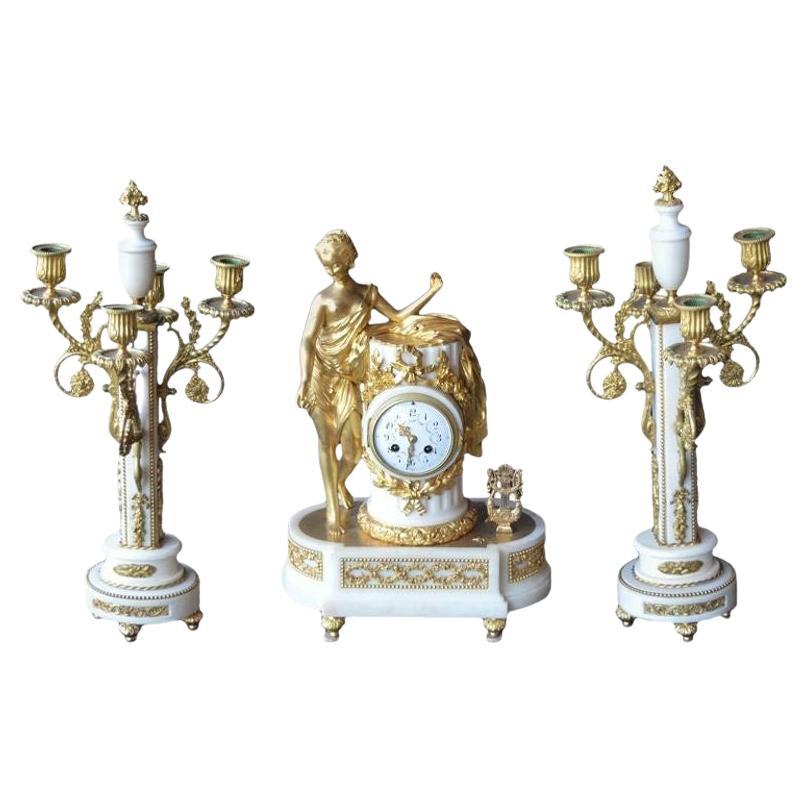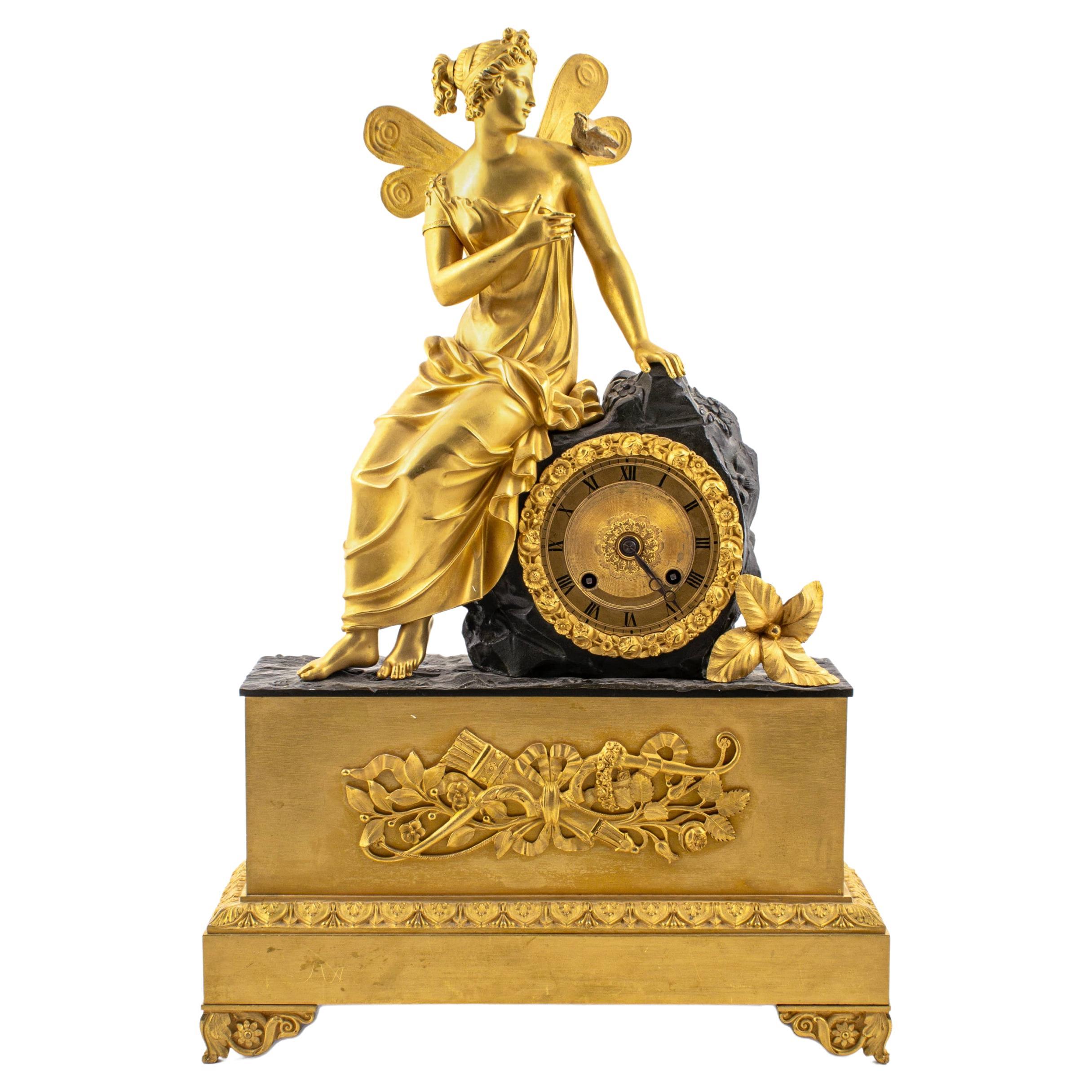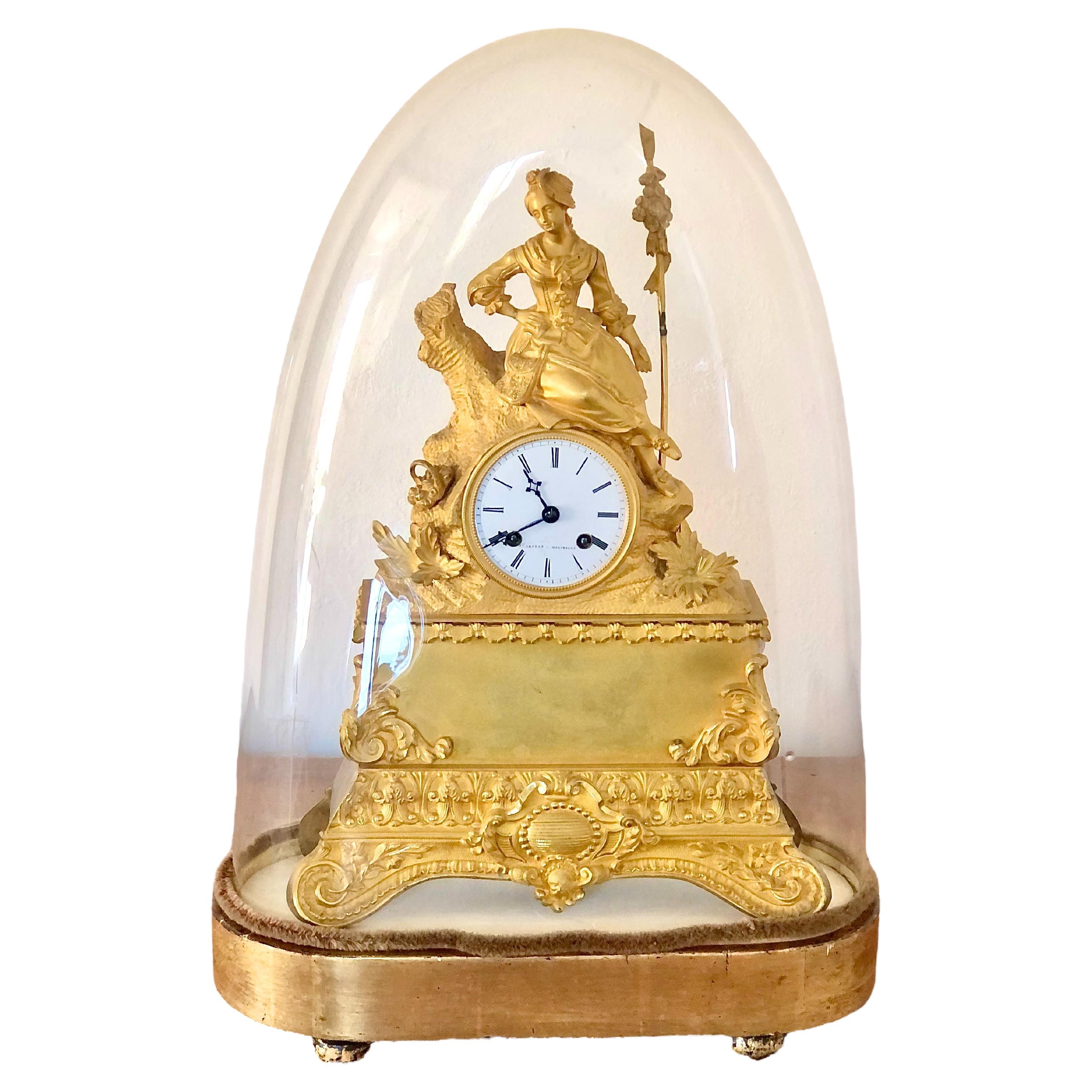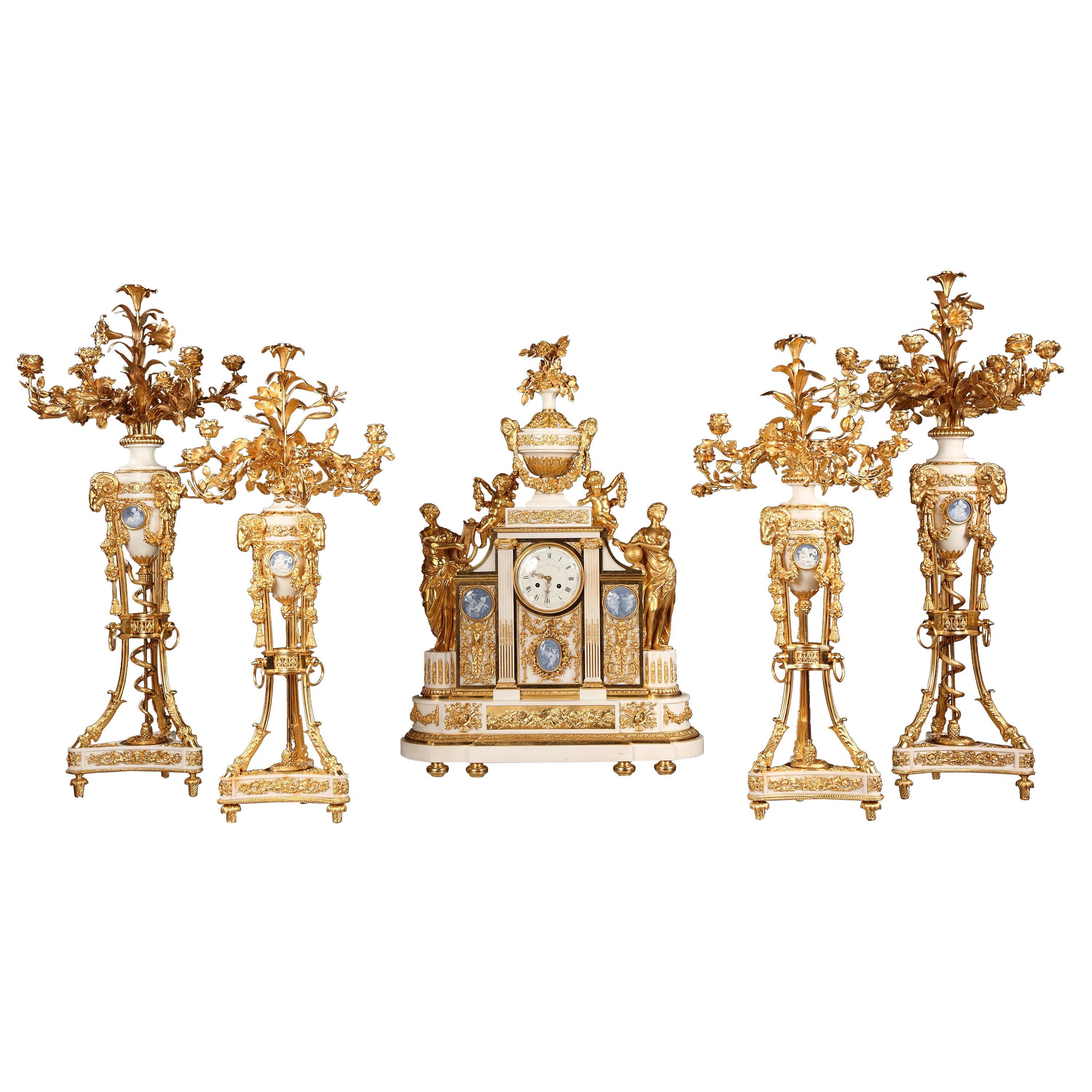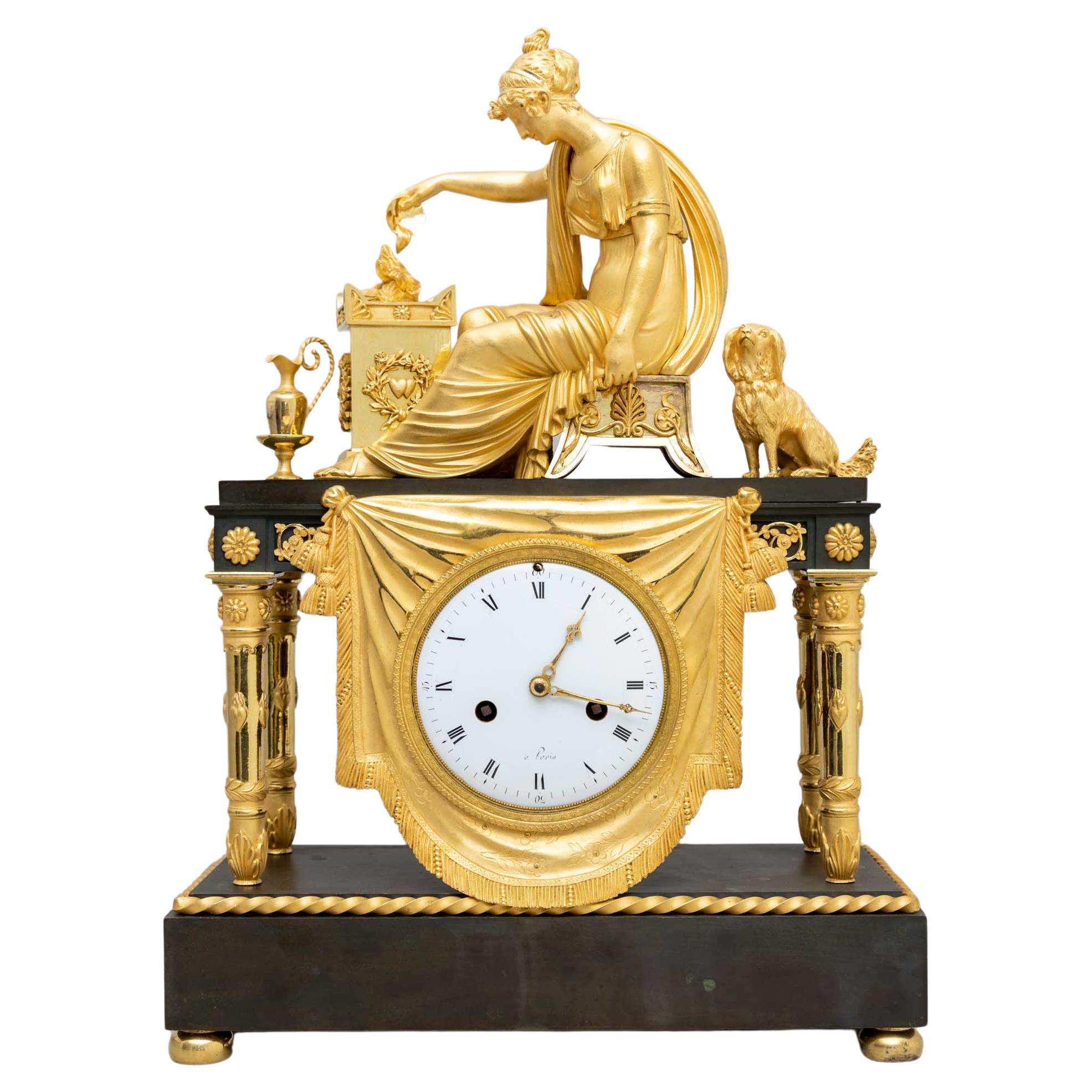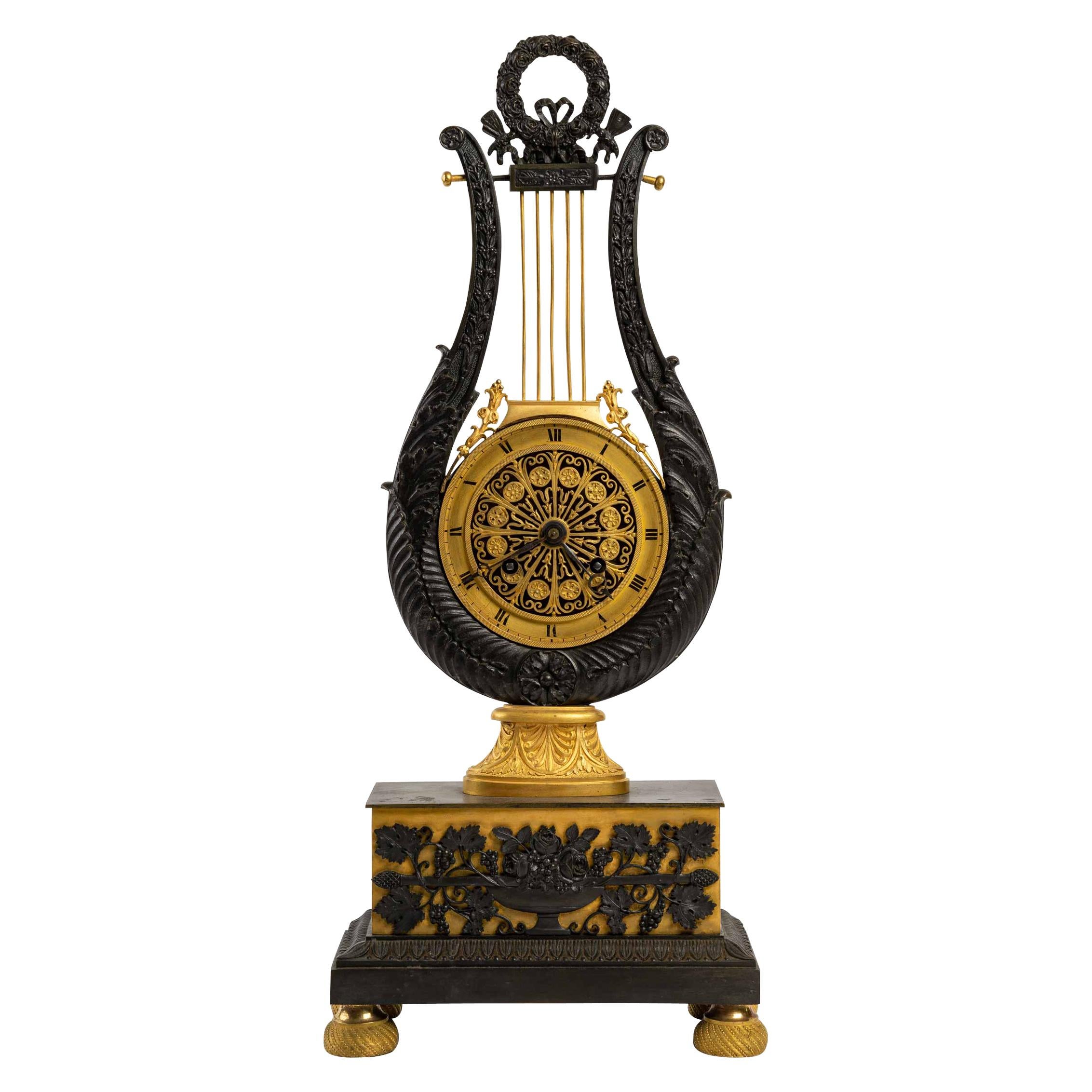Items Similar to Leila and the Giaour Gilded Bronze Clock, France, Circa 1830
Want more images or videos?
Request additional images or videos from the seller
1 of 14
Leila and the Giaour Gilded Bronze Clock, France, Circa 1830
About the Item
Dial signed Polti Frères
Measures: With base or glass: Height 61 cm (24 in.), width 51,5 cm (20.3 in.), depth 23.5 cm (9,2 in.)
Without base: Height 52 cm (20,5 in.), width 42 cm (16.5 in.), depth 12.5 cm (4.9 in.)
Important philhellenic clock in burnished and amati gilded bronze, finely chiseled, representing on the terrace a couple elegantly dressed in "the turkish style", and richly decorated with foliage, scrolls and flowers. The feet, decorated with water leaves, rest on an oval wooden base covered with a globe.
The theme of the clock comes from The Giaour, a fragment of a Turkish Tale, an English poem by Lord Byron published in may 1813 which tells the thwarted love of a Venetian, the Giaour – term by which the Turks designate infidels and especially Christians – and of Leila, a slave belonging to Hassan’s seraglio, military leader of a Turkish province. The betrayal of Leila discovered, she will be thrown into the sea and her lover will avenge her by killing Hassan, then taking refuge in a monastery.
Symbol of prestige and modernity, the decorative clocks are a reflection of the taste of the era of a wealthy bourgeoisie and may be the subject of diplomatic gifts or between individuals.
Beyond the purely decorative aspect of such objects, watchmaking in the 19th century is part of a subtle mix of political, historical and literary references.
This philhellenic movement converning the West finds a particular echo in France, one of the countries with the United Kingdom and Russia having suported the Greeks during their war of independance (1821-1830) to free oneself from the grip of the Ottoman Empire. Many clocks have been made, highlighting the courage of the fighters, celebrating the heroes of this war of independence and exalting national sentiment, inspired by contemporary literature evoking these events.
Related work :
Leila and the Giaour clock Gilded bronze, H. : 58 cm Reproduced in Les heures du Philhellénisme, les pendules philhelléniques françaises, Stéphan Adler, Editions Olkos, Athènes, 2018, p.271 (photo n°1).
- Dimensions:Height: 24.02 in (61 cm)Width: 20.28 in (51.5 cm)Depth: 9.26 in (23.5 cm)
- Materials and Techniques:
- Place of Origin:
- Period:
- Date of Manufacture:circa 1830
- Condition:
- Seller Location:PARIS, FR
- Reference Number:
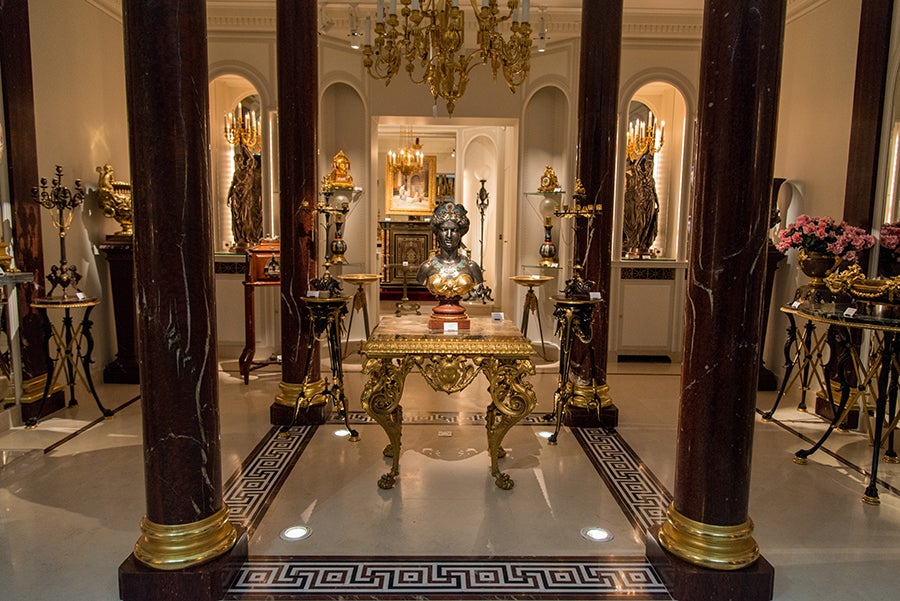
About the Seller
4.9
Vetted Seller
These experienced sellers undergo a comprehensive evaluation by our team of in-house experts.
Established in 1997
1stDibs seller since 2018
73 sales on 1stDibs
Typical response time: <1 hour
Associations
International Confederation of Art and Antique Dealers' Associations
- ShippingRetrieving quote...Ships From: PARIS, France
- Return PolicyA return for this item may be initiated within 7 days of delivery.
More From This SellerView All
- Important Five Pieces Marble and Gilded Bronze Clock Set, France, Circa 1860By Henri PicardLocated in PARIS, FRMarked on the dial Furet & Bon, Hrs du Roy, à Paris Measures: Clock – Height 98 cm (38 1/2 in.), width 70 cm (27 1/2 in.), depth 25 cm (9 3/4 in.) Candelabra – Height 116 cm (45 ...Category
Antique 1860s French Louis XVI Mantel Clocks
MaterialsMarble, Bronze
- "Geniuses of the Arts" Gilded Bronze and Marble Clock Set by G. Fabre, c. 1900By G. Fabre, Samuel MartiLocated in PARIS, FRDial signed G. Fabre, 4 rue des Filles du Calvaire, Paris Clockwork signed Samuel Marti – Médaille d’Or 1900 A Louis XVI style gilt-bronze and statuary Carrare marble clock set, consisting of a clock and a pair candelabra...Category
Antique Early 1900s French Louis XVI Mantel Clocks
MaterialsMarble, Bronze
- Neo-Egyptian Bronze and Marble Clock Attributed to G.Servant, France, Circa 1870By Georges Emile Henri ServantLocated in PARIS, FRA black and red marble clock in the shape of an Egyptian temple attributed to G. Servant, flanked by double columns inscribed with hieroglyphs and ornated with a winged uraeus, all made in two patina bronze. The clock is surmounted by a patinated bronze sphinx. Resting on four bronze faces wearing the nemes and terminating in lion paw feet. Georges Emile Henri Servant (circa 1828-1890) who took over his father in 1855 at their foundry, rue Vieille-du-Temple, in Paris, specialized in the production of neo-Egyptian style clocks, very popular in France since 1860s, and also the making of Greek style decorative objects. He drew considerable attention to the high quality of his bronzes at the 1855 Paris Universal Exhibition and then at the 1862 London Exhibition. At this time Servant exported up to 40% of his production, principally to the United States, where for instance, his sphinx clocks were sold with great success by Louis Tiffany Inc. or Hamann & Roche of New York (A similar clock is now exposed at the Metropolitan Museum of Art, New York). But his success came really at the 1867 Paris Universal Exhibition, where he was awarded a gold medal for his neo-Greek and Egyptian works (Les Merveilles...Category
Antique 1870s French Egyptian Revival Mantel Clocks
MaterialsMarble, Bronze
- Lovely Ormolu Clock "à la balançoire", France, Circa 1820Located in PARIS, FRFloral and decorated neoclassical ormolu clock, figuring two baluster columns joined together by a floral arch, and topped by a crown of rose...Category
Antique 1820s French Restauration Mantel Clocks
MaterialsOrmolu
- Fine Neo-Greek Clock Set by H. Houdebine, France, Circa 1867By Henri HoudebineLocated in PARIS, FRDial signed H. Houdebine, Fabricant de Bronzes, Rue de Turenne 64, Paris and clockwork signed Japy Frères & Cie – Médaille d’Honneur A very fine neo-Greek style clock set made up of...Category
Antique 1860s French Greek Revival Table Clocks and Desk Clocks
MaterialsBronze
- Louis XV Style Porcelain Clock Attributed Samson & Cie, France, circa 1880By Samson & CieLocated in PARIS, FRCharming polychrome porcelain, green lacquered metal sheet and chiseled gilt bronze Louis XV style clock attributed to Samson & Cie. A gilt bronze bush, decorated with small porcelain flowers and metal sheet foliage, supports the circular face, with Arabic numbers for hours. Rests on a gilt bronze foliage base decorated with a porcelain family scene composed of two parents playing and embracing their child. This type of clock first appears during the reign of Louis XV. The importation of exotic goods and the opening of the Turkish Embassy, in Paris in 1721, considerably influenced Louis XV style, with the apparition of exotics characters, scenes and animals ornamenting...Category
Antique 1880s French Louis XV Table Clocks and Desk Clocks
MaterialsBronze
You May Also Like
- French Marble and Gilded Bronze Clock SetLocated in Los Angeles, CADetailed marble French clock set embellished with gilded bronze.Category
Antique Early 1800s French More Clocks
MaterialsMarble, Bronze
- Louis Phillippe Bronze Clock, France, c 1830-1840Located in Kastrup, DKLouis Phillippe gilded and dark patinated bronze clock. Young woman adorned with wings and a bird on the shoulder sitting on rock block. Gilt dial with wreath of flowers. Included ke...Category
Antique Mid-19th Century French Louis Philippe Mantel Clocks
MaterialsBronze
- French Antique Gilded Chiseled Bronze ClockLocated in LA CIOTAT, FRA superb quality 19th century French bronze gilt mantel clock, retaining its original glass dome, and adorned with a finely detailed rustic female figure in period dress, reclining o...Category
Antique 19th Century French Mantel Clocks
MaterialsBronze
- Fire-Gilt Mantel Clock, France / Paris, circa 1830Located in Greding, DEFrench mantel clock made of burnished and fire-gilded bronze with an enamelled dial, there inscribed "'a Paris". The pendulum stands on a rectangular base with turned moulding, above...Category
Antique 1830s French Charles X Table Clocks and Desk Clocks
MaterialsBronze, Enamel
- Clock in Gilded and Patinated BronzeLocated in Saint-Ouen, FRClock in gilded and patinated bronze from the Charles X period, 19th century. Measures: H 43 cm, W 19 cm, D 10 cm.Category
Antique 19th Century European Charles X Table Clocks and Desk Clocks
MaterialsBronze
- Antique French Gilded Bronze Cartel Wall ClockLocated in Victoria, BCFrench clockmakers were renowned for their craftsmanship during the 19th century. An antique framed hanging Cartel wall clock made of gilded bronze. The hours are shown as Roman nu...Category
Antique Late 19th Century French Art Nouveau Wall Clocks
MaterialsBronze, Enamel
Recently Viewed
View AllMore Ways To Browse
The Grip
English Gilded Furniture
Clocks Made In France
Gilded Clock
Manyal Clocks
Furniture Of French Leaders
Clock Clock 24
French Country Bronze
Clock Clock24
Gilded French Clock
Brown Bronze Clock
Wood French Mantel
Important Clocks
French Wood Clocks
Gilded Dress
Gilded Bronze Clocks
Gilded Era
French Clock Flowers
